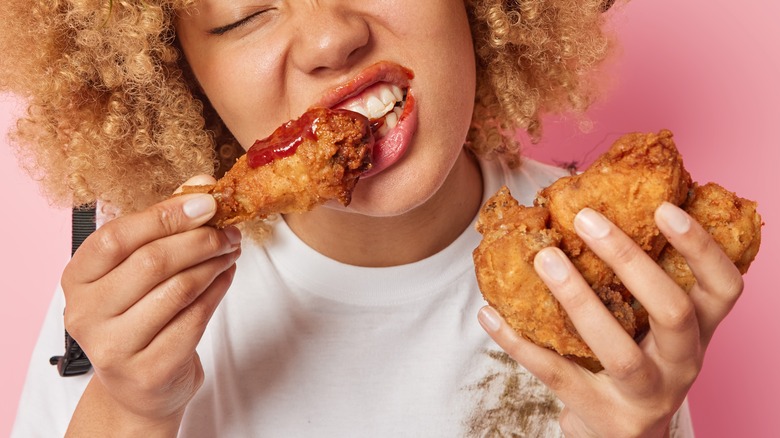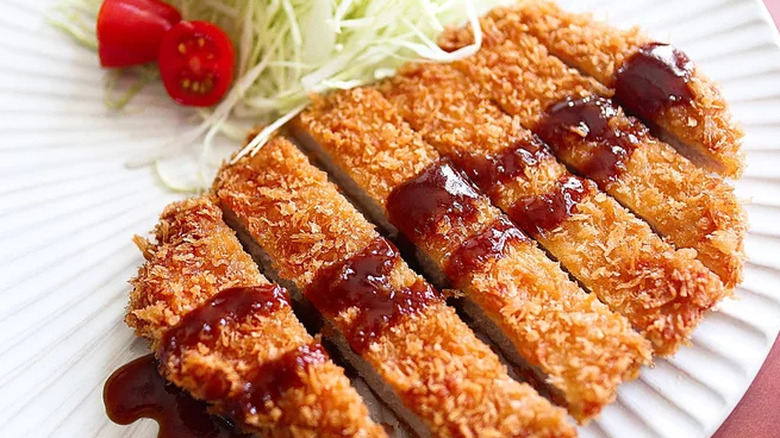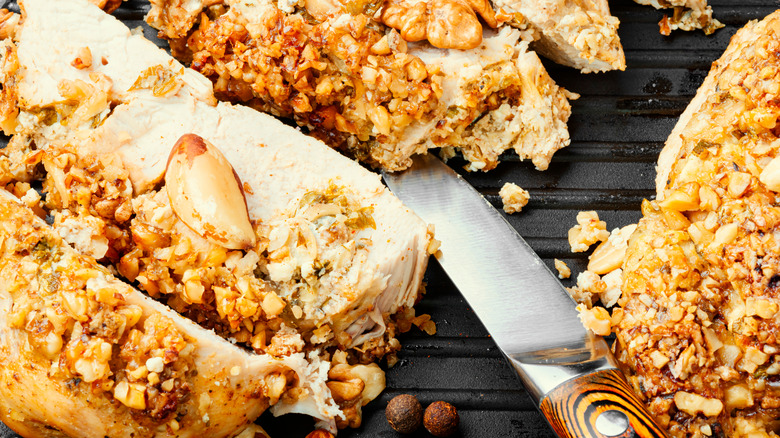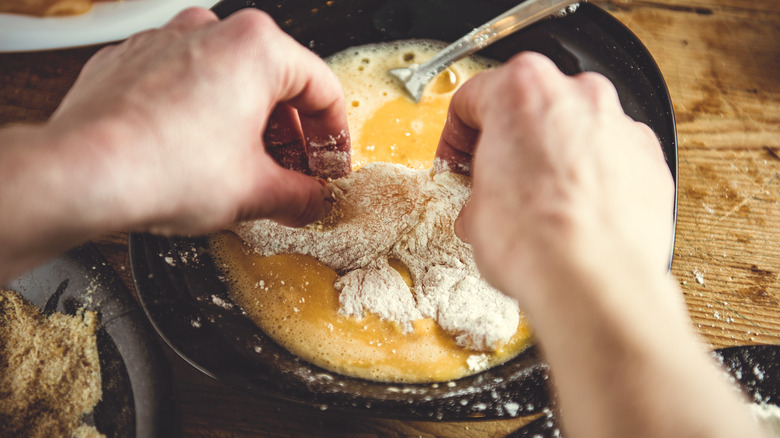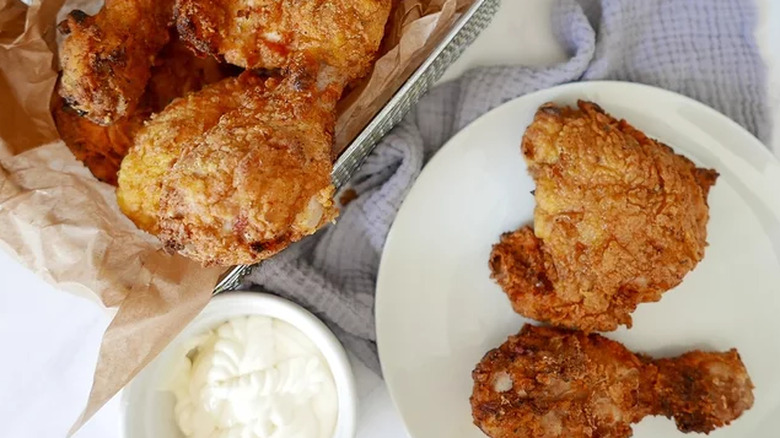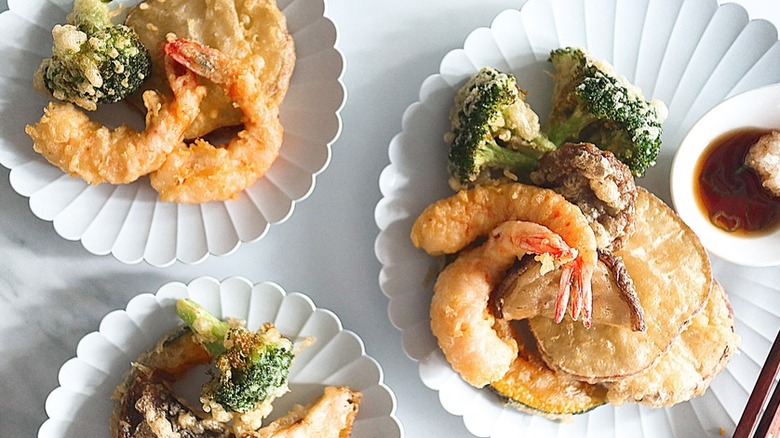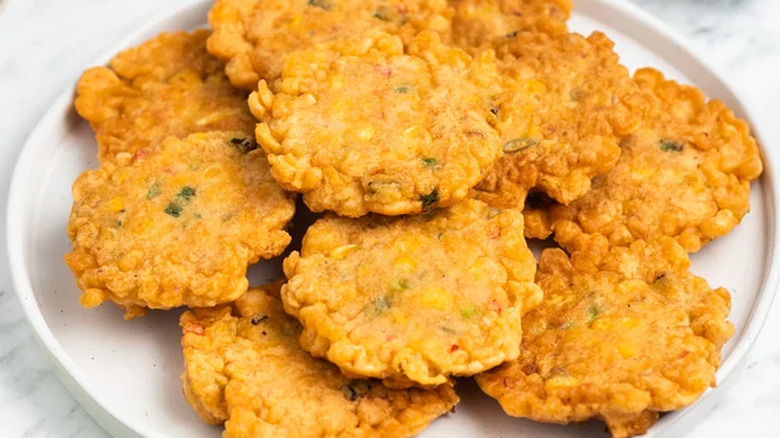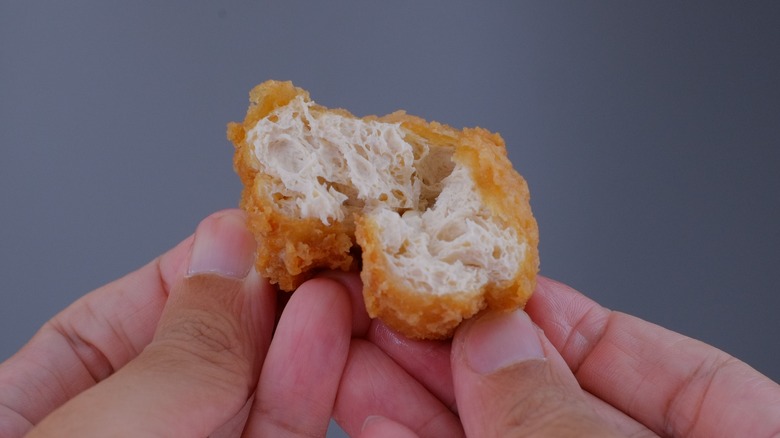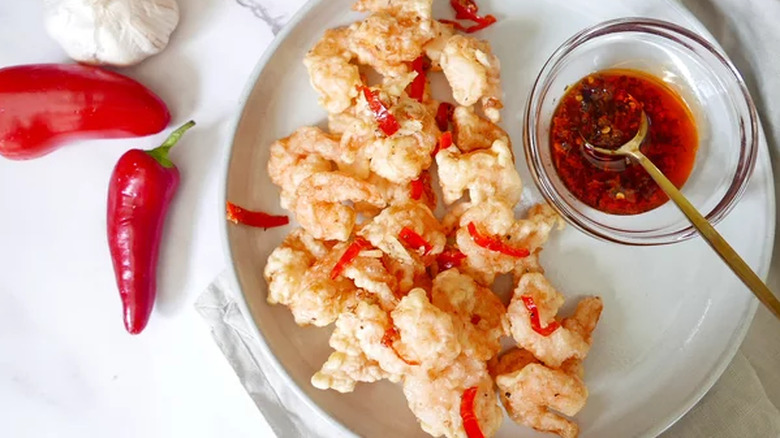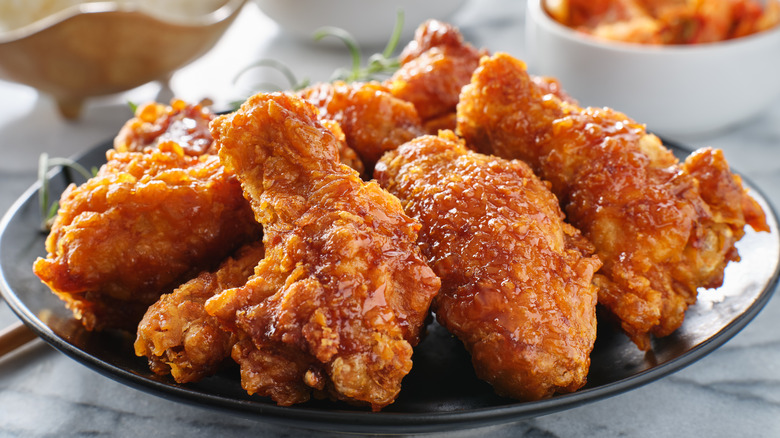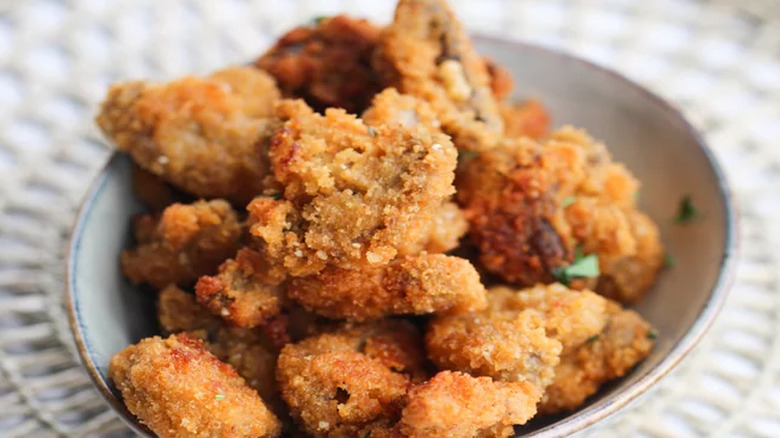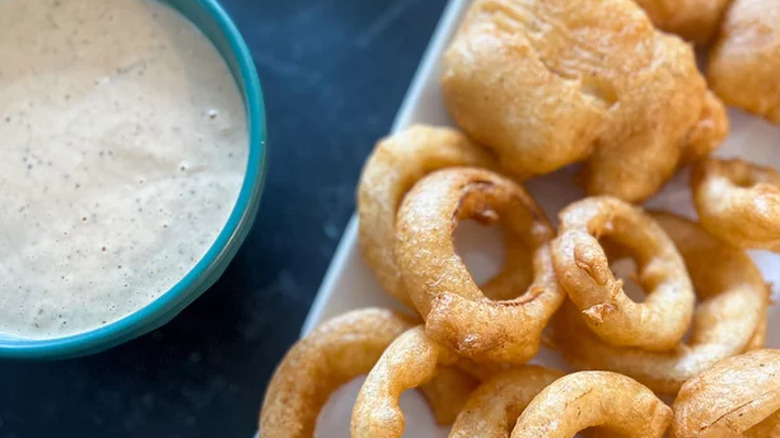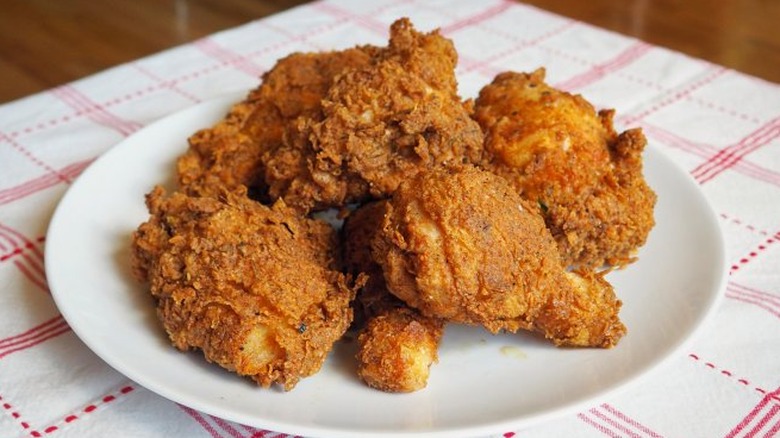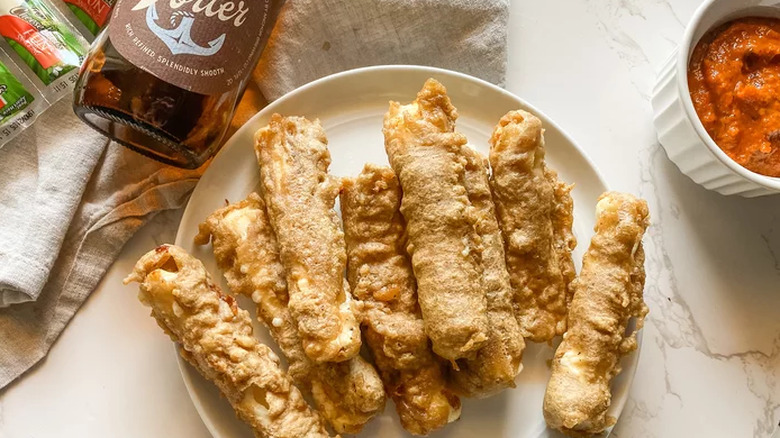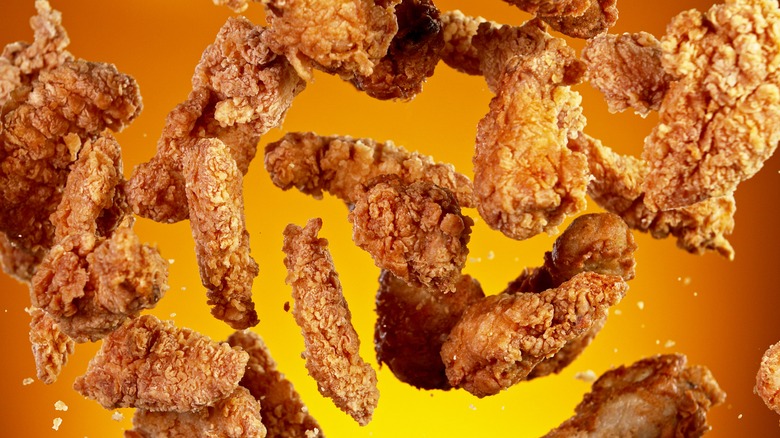14 Tips On How To Create A Crispier Coating
Biting into an audibly crispy coating is a universally loved sensation, especially if the inside is sublimely soft and tasty. It's also versatile, since you can create a crunchy casing for just about any food. You can make crispy tofu nuggets for a meat-free snack, or crispy fried trout for a more sophisticated entrée. These dishes are often fried, but if you want to cut down on the saturated fats, then you can also adapt by using an air fryer or baking. However, when you cook a crunchy treat, the real challenge is making sure that your crispy coating doesn't go limp, become soggy, fall off, or even turn chewy.
The ingredients you use and the temperature you cook at, as well as the technique all, make the difference between success and failure. There's no hiding behind complexity for many of these recipes. After all, breaded and baked chicken tenders and air-fryer crispy cod are either crunchy or they're not. What adds to the difficulty is that it's not just the coating that counts; it's also the kind of food you're using it for. There's a big difference between a thin and slippy onion ring and a piece of chicken on the bone. To make it easier, here are some of the best tips to help you achieve a crispier coating.
Use panko
While panko is made from bread, it isn't the same as regular breadcrumbs. It is the Japanese version, made from bread without any crusts. It's becoming popular beyond Asian cuisine, and a must-have kitchen staple for many home chefs in the U.S. because of its super crispy texture.
You may use panko if you make Asian dishes with a crispy coating, such as katsu, tonkatsu, or donkatsu. However, you can also try our variety of panko recipes whenever you're craving a crunchy coated bite. Panko is lighter and crispier than other breadcrumbs and soaks up less oil. This gives it a more delicate texture that also tastes less greasy and is less prone to becoming heavy and soggy.
You use panko flakes in the same way that you would breadcrumbs. If you're wondering how to decide, then note how the Japanese version doesn't have a strong flavor. This might not be the case if you make your own breadcrumbs from different types of bread. If you're seeking to create a crispy yet fairly robust crumb, then you may want to opt for breadcrumbs that add a heavier layer. Meanwhile, you can also give dishes such as crumbles a crunchier topping with a sprinkling of panko.
Add chopped nuts to chicken
Our chicken schnitzel has to be one of the simplest recipes. With just a few ingredients, you can achieve that soft-protein-and-crispy-coating combo that's so irresistible. A squirt of freshly squeezed lemon juice soaking into the fried crumb coating finishes the dish off perfectly. However, you do have to take care while cooking it. You want to find that balance whereby the meat is cooked thoroughly and the breadcrumbs or panko coating is perfectly crispy.
There's a straightforward way to elevate the crunchiness and flavor profile of this classic German dish. All you need are some finely chopped nuts added to your breadcrumbs. You can choose whatever nuts you like: Try pecan-crusted chicken, for instance, or opt for almonds, pistachios, or even peanuts. The oiliness of the nuts uplifts the tastiness, enhances the crumbed coating, and also adds extra moisture so that the meat doesn't dry out.
If you want a more distinctively nutty texture and taste, then you could leave the nut pieces fairly large and roughly chopped. However, you'll want the nuts to mix in well with the breadcrumbs (and thus be of a similar size).
Dredge, dip, and bread
If you dip foods in flour and fry them, it will make the outside brown and possibly crisp up a little. But a light dusting of flour isn't going to be enough to get an audible crunch when you bite into a coated bite. You can choose whether to deep fry, shallow fry, oven bake, or cook in an air fryer. However, to get the right texture outside, follow a three-step process that's tried and tested: Dredge, dip, and bread. For some recipe inspiration that uses this method, try our breaded pan-fried cod.
Line up three dishes that aren't too deep. Add flour in one, and liquid (such as a classic egg and milk wash) in the other. If you'd rather use buttermilk or beer, you can do that, too. It really depends on the individual recipe or your preference. The third step is to coat whatever you're making in breadcrumbs. And don't forget that you can season your meat with herbs and spices as well.
Double dredge chicken
You can also try our crispy fried chicken recipe if you don't want to bread, but still want a crispy outside. Submerge the meat pieces in a buttermilk-egg mixture first. Then, dredge in flour before repeating and then deep frying.
Another method to help keep the meat juicy and the outside in place without sliding off is to double dredge: Dip chicken pieces into an egg and milk wash, then cover them with seasoned flour. Use a pair of tongs to make this easier, or use separate hands for dipping and dredging. Next, put the floured meat back into the eggy mix. You can then choose to simply dredge once again in the flour before frying or add a crumbed coating after this second dip.
Don't feel as if frying is your only option, either. You can sear the coated meat in a frying pan before baking it in the oven. That way, the final result is less greasy, but you won't be losing that classic fried texture.
Keep tempura from getting soggy
Delicately crunchy Japanese tempura dipped in soy sauce with some wasabi heat is a crunchy snack favorite. Our tempura is made with shrimp, shiitake mushrooms, and kabocha squash, along with broccoli florets and sweet potato. To get that signature light batter just right, combine flour with baking powder and cornstarch with a pinch of salt. Then, add cold seltzer and mix. Whatever tempura you make, from carrot strips to squid, the secret to its tastiness is undoubtedly that artistically fried batter that looks so dramatically delicious.
Meanwhile, there's nothing worse than soggy tempura. What's key is to only batter and fry when you're ready to serve, or the batter will start to lose some of its crispness. It isn't just timing that can help, though. When you combine the dry and wet ingredients to make the batter, don't mix them too vigorously. The science behind this is that stirring too much results in gluten formation. This reduces the crispiness and gives the batter a stodgier texture.
Another tip is to add sparkling water to the batter, either alone or mixed with regular water. You can use fizzy club soda or even beer if you prefer. The bubbles heat up so that the coating reacts with the hot oil to create a bubbly batter.
Crisp up delicate food with baker's yeast
Our crispy corn fritters are such a tasty snack. Even better, you don't need any fancy ingredients to make them. What gives them such a moreish essence is the batter and how it sizzles and crisps up in the pan. To give them a crunchier texture, make the batter according to this recipe, with cornstarch, flour, and baking powder. You want the texture to be fairly light so that you can eat a few. If that batter isn't delicate enough, then you're going to get a doughy texture which makes your fritters a little heavy.
If you're making a fritter and want to fry delicate food without it breaking up, then you need the right batter. That means a batter that's not too heavy and creates a wonderfully protective crispy coating. The secret ingredient is baker's yeast, which acts on the ingredients to create a leavened batter. According to Cookist, this type of batter is ideal for soft fillings such as zucchini or zucchini flowers. Combine 10 grams of brewer's yeast with 250 grams of flour and mix with 500 milliliters of water. A good tip is to pummel the mixture with your hands to get the air in, for a softer textured result.
Tear up tofu and coat
If you're a tofu fan, then you probably love its meat's soft texture. And while you can't really fry with silken tofu, there are firmer varieties that are ideal to add to a stir-fry.
If you want to make our crispy chili tofu, you'll have to start by making sure that the tofu is drained properly. Getting rid of excess water is essential, and you can do this by weighing down the block before cutting it. Toss the tofu cubes in cornstarch before frying, so that they get a deliciously crunchy texture on the outside. Biting through this to the velvety soybean curd is a simple joy.
Another great tip to increase crunchiness involves how you cut up the tofu before coating it. Most recipes suggest cutting your pressed and drained tofu block into bitesize squares. Try tearing it up instead. The rough edges are going to fry crispier than smooth, cut sides. The jagged texture traps the oil, and it also means that any flavors that you add are more intensely present, too.
Make a light and crispy shrimp bite
Is there anything more, er, moreish than deep-fried shrimp? Because the seafood cooks so quickly, you need a coating that's going to crisp up immediately. To create a light texture, you might want to simply dredge your shrimp in a little flour. This dusting is enough to brown the outside, but it's not going to get a good crunch on it. Make our crispy fried shrimp by dipping each succulent piece in whisked-up egg whites. Then, dip them in cornflower. When plunged in hot oil, they'll turn golden brown and crispy in just a few minutes.
Biting At The Bits highlighted and reviewed four ways of crisping up juicy red shrimp: plain flour, cornmeal, rice flour, and semolina. Per the results, cornmeal creates a really crispy coating, and is ideal if you're not adding a batter or any other coatings to your shrimp. Another plus point is that cornmeal is gluten-free, and also adds some flavor. Still, try them for yourself and see which ingredient works best for you.
Double fry chicken
Some home cooks pride themselves on creating gourmet dishes with complex culinary techniques and high-end ingredients. However, while this is impressive, it's also amazing how many experienced chefs fail when it comes to making simple fare that is exactly how it's supposed to be. For example: You can't get much more basic than fried chicken, but getting it super crunchy isn't always easy. For our Korean fried chicken recipe, the method for making the wings crispy involves covering them with cornstarch before frying. But another good way to accomplish this is to double-fry your chicken.
Whether you simply dredge the meat in flour or cornstarch or make a light batter, double-frying affects the texture. Drop whatever chicken you're frying into hot oil (carefully, of course). Once the skin starts to become harder, take the meat out and let it rest. The water in the meat and skin will evaporate without the chicken cooking in the oil. Then, plunge the pieces back in the oil so that the skin crisps up quickly and the meat doesn't overcook and dry out. This method is popular in Korea; unsurprisingly, Korean fried chicken is renowned for being crispier than its counterparts in the U.S. and other parts of the world.
Fry breaded mushrooms at the right temperature
Mushrooms are funny fungi. If you cook them right, they are so ridiculously good — but if you get it wrong, they can taste overly soft and even slimy. If you're into cooking, then you probably already know that it's best to wipe mushrooms to clean them rather than drench them in water. If they're not dry when you fry them, then they're not going to be tasty at all.
A lovely way to enjoy fried mushrooms is to bread them. The softness of the mushroom juxtaposed with a crispy outer coating just works. Case in point: our parmesan crusted fried mushrooms. Make a batter with paprika and garlic powder, and then coat in breadcrumbs with grated cheese. However you bread your mushrooms or whichever seasonings you use, the key is to make sure you're frying at the right temperature. Instead of a batter, you can dip mushrooms in flour, then an egg wash, and then either regular breadcrumbs or panko. Heat oil that can withstand high temperatures to between 325 and 400 degrees Fahrenheit. Within this range, the mushrooms will cook without turning soggy from insufficient heat, and the breadcrumbs will turn brown without burning. It's also a good idea to add salt once the mushrooms are cooked, as adding it beforehand may affect the quality of the oil and the frying process.
Coat onion rings with the right amount of batter
A beloved snack in the U.S. – especially when served alongside a burger — is onion rings. (Our crispy beer batter recipe works well for this, and is made with flour, baking powder, and (surprise, surprise) beer.) A particularly useful onion hack that can make cooking easier revolves around making sure that the coating doesn't slip off the onion. It basically involves removing the thin membrane on the inside of the slice.
If you've ever bitten into an onion ring and the slice pulls away from the outside, then that might also be because it's not cooked enough. Another reason why onion rings can fail is if they're soggy and lack any type of crunch. This is often due to the rings being weighed down by batter.
Of course, if you don't have enough batter (or it's too thin and doesn't stick to the onion properly), then that's going to affect the end result as well. In this instance, the onion may start to frazzle, as it's not protected by the batter.
Rest fried chicken in the oven
If you love fried chicken, try our easy copycat KFC chicken. It's made with a buttermilk marinade and 11 herbs and spices added to that iconic crispy coating. You can also add a sprinkle of MSG to enhance the flavor.
The U.S. fast-food chain cooks its chicken using commercial pressure cookers. At home, you have to get the temperature just right, as you're cooking chicken on the bone and you want it to cook through without burning the outside. A good tip is to fry the chicken as soon as you've coated it in flour. Also, make sure that you do one dusting, and that the flour is pressed firmly into the meat.
A KFC insider tip reported in Reader's Digest suggests that the chain also keeps chicken in a warmed oven for 20 minutes before serving. You can transfer your fried chicken to an oven that's heated to around 175 degrees Fahrenheit for a shorter amount of time. You have to try it out to see what works best. The idea behind this is that this allows the chicken to cook while still retaining the crunchy coating (since the oven doesn't soften it).
Add bubbles to batter
Our copycat Long John Silver's fish is scrumptiously crunchy. When you make the batter, you add baking soda and baking powder to create a light and airy battered cod. As you would with a tempura batter, you can also add club soda or any type of bubbles you like (such as seltzer water). To make sure your batter is smooth, it's a good idea to add your bubbles to the dry ingredients slowly.
You can also use alcoholic bubbles. If you want a more luxurious approach, try adding some cava, prosecco, or champagne to the mix. The bubbles release carbon dioxide when they're heated up; this creates air pockets in the batter. The presence of these air pockets results in a crispy, light batter. Another idea is to add lemonade to your fish batter: It sweetens the taste, adds some flavor-rich acidity, and also helps the batter turn lovely and brown.
Choose the right coating - but don't be afraid to experiment
A significant part of what makes cooking so enjoyable is trying out different techniques and ingredients to see what works best. For example, there are various methods for making your coating crispy, whether it's for frying fish, chicken wings, or shrimp. Don't be afraid to try ingredients other than flour and breadcrumbs to get the level of crispiness you crave.
One particular technique for achieving a crispy coating is more "krump" than "crumb": According to Time Out, hip-hop star Snoop Dogg likes to crunch into chicken wings with a potato chip coating. You can make these yourself by checking out our potato chip hacks feature.
Another crispy coating tip is to use smashed-up dried noodles. These work well with potato croquettes made from mash. Once you've shaped your snacks and dipped them in batter, cover them in broken bits of instant dried noodles, then deep fry them.
